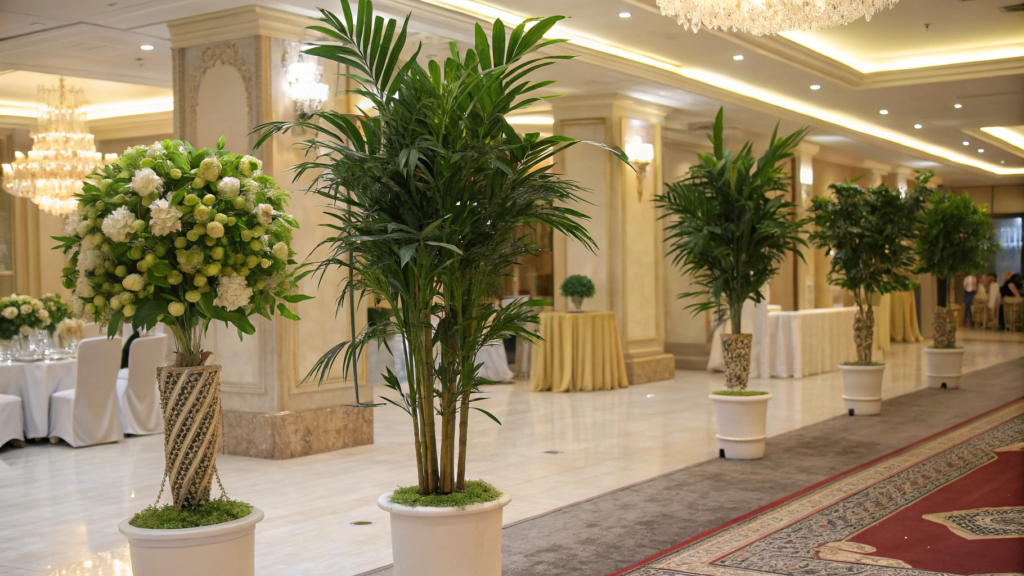We’ve all been there—walking into a space and instantly spotting those cringe-worthy fake plants that might as well have a neon “FAKE” sign. As professionals who have seen it all, we understand why clients gravitate toward artificial plants: no midnight watering guilt trips, no dead leaves to sweep up, and no plant funerals.
But here’s what makes us want to pull our hair out: watching gorgeous interior designs get completely sabotaged by obviously cheap faux greenery. Whether we’re transforming someone’s dream home or designing a flagship store, the gap between “wow, those are beautiful” and “yikes, those are fake” comes down to insider knowledge.
Here’s the thing nobody tells you: today’s artificial plants can be mind-blowing when you know the tricks. We’ve watched seasoned gardeners get fooled by well-executed artificial arrangements.
At FeelReal, we’ve spent years perfecting artificial plants that make even plant snobs do double-takes. Below are 10 tips to help you nail that “wait, are those actually real?” moment every single time.
Tip 1: Start with High-Quality Artificial Plants
Cheap plants will always look cheap. Thus, start with high-quality materials like high-grade silk, UV-resistant plastics, and flexible wire stems.
Your hands know quality instantly. Premium pieces feel substantial and move naturally, just like real greenery.
| Material Type | Benefits | Best For |
| Silk Foliage | Realistic texture, natural drape | Indoor luxury residential |
| UV-Resistant Plastics | Weather durability, fade-proof | Outdoor patio, balcony landscaping |
| Wired Stems | Flexible positioning, memory | Trees, bushes, hanging vines |
At FeelReal, we obsess over details most people feel but never consciously notice. Intricate leaf veining, natural branch curves, subtle color variations—these details create authenticity.
Cheap imitations betray themselves immediately. Plastic shine, flawless symmetry, and brittle stems are instant giveaways.
Best-in-class faux plants aren’t just decor. They’re investments that look convincing today and for years to come.
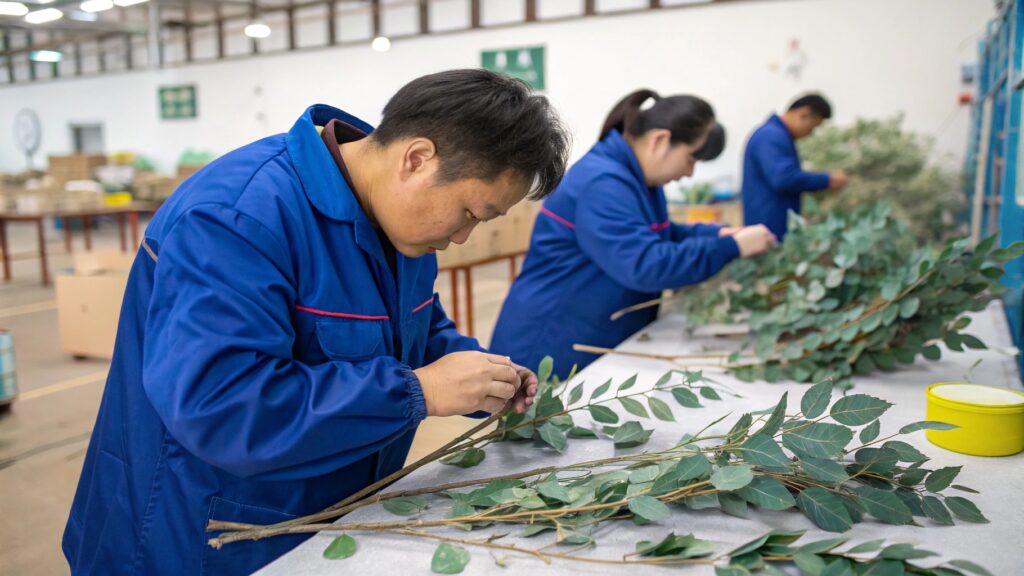
Tip 2: Shape Artificial Plants for a Natural Look
Okay, here’s where we see people face-plant every single time: they unbox their plants and just plop them down like garden statues. Don’t be that person who treats imitation plants like furniture that never moves.
Shipping destroys any natural shaping. Your beautiful plants arrive looking flatter than roadkill—compressed, bent, and about as lifelike as a cardboard cutout.
This is your moment to play plant whisperer. Seriously, block out 20-30 minutes per piece and get your hands dirty. Start fluffing that foliage, then get obsessive about individual stem positioning.
Think like a real plant would: some branches desperately reaching toward that window light, others getting lazy and drooping under their weight. Leaves should twist and turn like they’re trying to catch sunlight.
Tall trees and palms are where this matters—they need serious TLC to look natural, rather than like telephone poles with leaves glued on. Each major branch should have its personality and story.
This applies whether you’re babying a delicate bonsai for some CEO’s office or wrestling Boston ferns into submission for a cozy living room. Even those naturally wild Boston ferns need strategic reshaping to nail that “perfectly imperfect” vibe.

Tip 3: Upgrade the Planter for Faux Plants
Nothing kills the illusion faster than seeing a gorgeous artificial plant sitting in an obvious plastic nursery pot. It’s like framing a masterpiece in a dollar store frame.
Your container choice communicates as much as the plant itself. Woven baskets say “casual comfort” and work beautifully in home environments. Sleek ceramic pots scream “sophisticated luxury” for upscale commercial spaces.
Scale matters enormously here. Large floor plants require substantial bases to achieve visual balance. Delicate bonsai requires containers that complement rather than compete.
The magic happens when you add natural textures. Fresh moss around the base, decorative stones, even real bark chips create that crucial bridge between synthetic and authentic.
| Container Type | Best Use | Style Benefit |
| Woven baskets | Indoors; residential spaces | Organic texture, warmth |
| Ceramic pots | Luxury commercial environments | Clean lines, sophistication |
| Weather-resistant planters | Outdoor patio, balcony | Durability, UV protection |
For outdoor applications on patios, balconies, or in backyard landscaping, weather-resistant containers are a must. Our potted selections work as complete systems. Plants and containers combine to create believable installations.
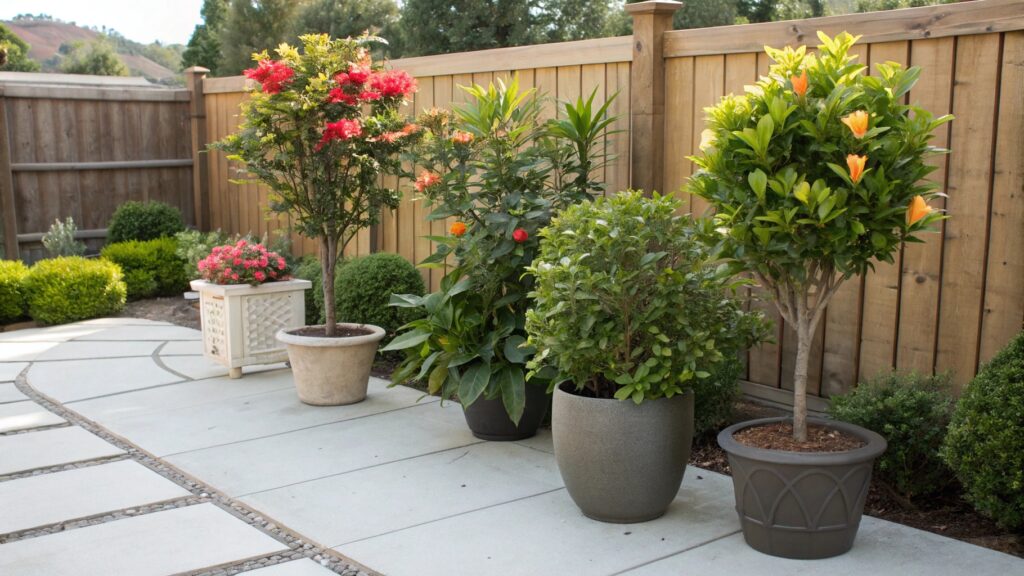
Tip 4: Add Natural Elements to Artificial Plants
This technique distinguishes advanced designers from beginners by strategically incorporating real elements with artificial plants. It sounds counterintuitive, but the combination creates believability that pure synthetic arrangements simply cannot achieve.
The key is subtlety. Preserved moss adds authentic texture and color variation. Dried flowers introduce seasonal elements and natural imperfection.
These accents work exceptionally well with hanging arrangements where people examine details closely, as well as floor displays that anchor larger spaces. Natural fillers transform basic potted arrangements into sophisticated compositions.
For outdoor spaces like patios and balcony areas, weathered wood elements and natural stone accents create a sense of environmental storytelling. This hybrid approach excels in commercial environments where visual impact is crucial but maintenance complexity must remain manageable.
The secret is restraint. A little real moss enhances artificial plants; too much creates care obligations that defeat the purpose.

Tip 5: Position Fake Plants in Natural Light
Light transforms everything. It’s the difference between imitation plants that convince and ones that don’t belong.
Position artificial plants where real options would naturally thrive. Try near windows, glass walls, or skylights. Just anywhere natural light flows consistently.
Natural light creates dynamic shadows that change throughout the day, adding movement and visual interest. Side lighting works exceptionally well, creating depth and dimension.
For outdoor placements on balcony spaces, patios, or in backyard landscaping, UV-resistant materials are essential. Our outdoor collection includes trees, grass, and flowers engineered for harsh conditions.
Many homes and commercial spaces have challenging lighting conditions that make it difficult for real plants to thrive. These problem areas are suited to high-quality artificial alternatives.
Tall trees and palms create dramatic silhouettes when positioned to catch attractive lighting. Smaller potted pieces work beautifully in areas with soft, indirect light, which enhances their natural, textured appearance.
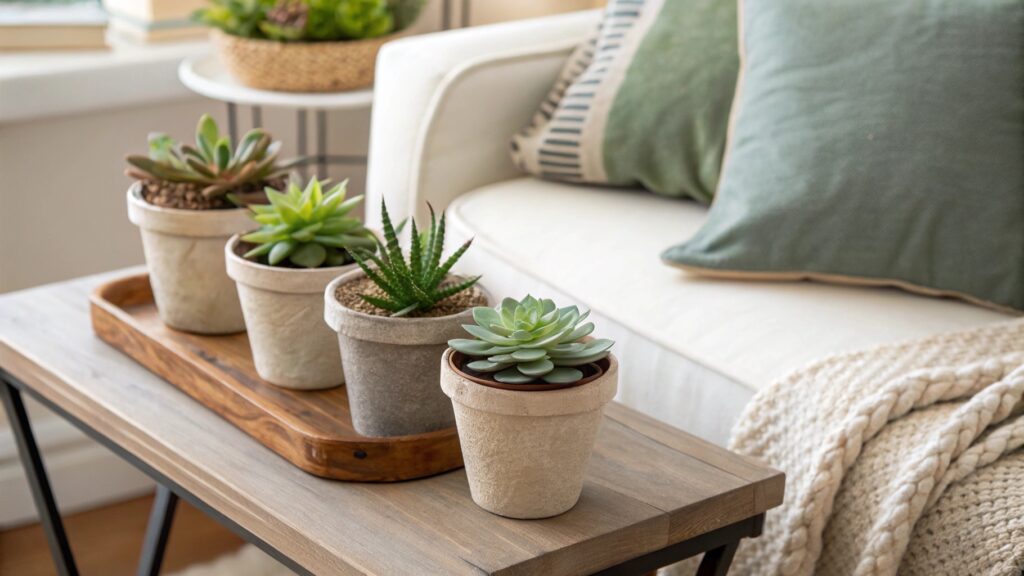
Tip 6: Clean and Maintain Your Artificial Plants
This is honestly where we see the most epic fails: drop-dead gorgeous artificial plants that someone just… forgets about. They spend hundreds on beautiful pieces, then let them turn into dust collectors that scream “FAKE” to anyone with functioning eyeballs.
Dust accumulation is the fastest way to blow a cover. It’s fixable nonetheless with these cleaning and care tips.
| Cleaning Schedule | Method | Plant Types |
| Weekly | Soft microfiber dusting | All indoor plants |
| Monthly | Gentle soap and water | Floor arrangements, large trees |
| Bi-weekly | Thorough brush cleaning | Outdoor plants, high-dust spaces |
Weekly dusting isn’t a suggestion—it’s mandatory if you want people to believe these things are real. Use microfiber cloths that grab dust instead of just pushing it around.
For those massive hanging arrangements and large trees that collect dust like magnets, invest in soft-bristled brushes that can get into all the nooks and crannies your fingers can’t reach.
Here’s something most people don’t realize: different materials need completely different TLC. Silk foliage is essentially the diva of the artificial plant world—it requires gentle handling to maintain its natural drape and texture.
FeelReal’s materials are engineered specifically to make your life easier. Our pieces actively resist dust attraction and won’t start looking fake after a few months of real-world use.

Tip 7: Add Perfect Imperfections to Plastic Decorative Plants
Here’s an advanced trick that separates the pros from the wannabes: real plants are beautifully messed up, and yours should be too. That Instagram-perfect symmetry? It’s essentially a giant red flag screaming “artificial” to anyone who has ever seen actual greenery.
Real plants have character and war stories. Leaves with tiny battle scars, stems that zigged when they should have zagged, subtle color variations that tell tales of sun exposure and seasonal changes.
Get in there and mess with your perfect plants a little. Strategically bend some stems, curl a few leaves as if they’ve been through some weather, and trim back any bits that look too pristine.
You can even play makeup artist with subtle paint touches—add tiny age spots or sun-stressed edges that make pieces look like they’ve lived a little. This works amazingly with plastic grass, ferns, and fillers in landscaping where everything should look slightly weathered.
Bonsai arrangements are where this technique shines. Real bonsai spend decades developing their gnarly, character-filled appearance—your artificial versions should hint at that same patient cultivation story.
Bushes and trees need those strategically placed branches that suggest wind patterns, growth struggles, and the beautiful imperfection of natural beauty.

Tip 8: Mix Artificial Plants with Real Greenery
Sometimes, the most convincing fake plants are those mixed strategically with real ones. This hybrid approach creates visual complexity that pure artificial arrangements cannot achieve on their own.
The combination confuses visual perception in the best possible way. When people see real plants mixed with artificial ones, their brains tend to categorize everything as authentic.
Combine artificial vines with real potted flowers for seasonal color. Nestle synthetic bushes among live shrubs in residential landscaping. Use living plants where they’ll thrive naturally, artificial pieces in challenging spaces.
This approach excels for backyard gardening and patio arrangements where environmental conditions vary dramatically. Whether working on house interiors or commercial projects, this maintains consistent greenery without the anxiety of keeping everything alive.
The result delivers year-round beauty with dramatically reduced maintenance costs.

Tip 9: Master the Strategic Placement of Artificial Plants
Effective placement is design science, not random decoration. Understanding visual principles transforms ordinary arrangements into a professional-quality installation.
Group your plants in an odd number pattern for a more natural visual balance. Height variation creates a natural-looking diversity that mimics how plants grow in their natural environment.
Large floor plants anchor empty corners and establish focal points. Potted palms frame entryways beautifully, creating seamless transitions between spaces. Bonsai pieces provide sophisticated accents on desks and shelving decorations.
Hanging arrangements add crucial vertical interest and create layered, visually appealing compositions. They’re particularly effective in spaces with high ceilings or limited floor area.
Scale relationships determine success. Big statement trees command attention in large commercial spaces and outdoor areas. Smaller arrangements create intimacy in home environments.
Consider traffic patterns and functional requirements. Position plants to enhance movement through spaces rather than obstruct it—greenery should feel welcoming and natural.

Tip 10: Seasonally Rotate Your Fake Plants
Here’s an advanced strategy: seasonal rotation maximizes your investment while keeping spaces feeling fresh and current throughout the year. Seasonal changes affect human psychology powerfully.
Bright flowers and fresh greenery energize spring moods. Rich leaves and rustic branches evoke the warmth of autumn. Even subtle winter accents can transform environmental feelings dramatically.
This approach works brilliantly for retail spaces, restaurants, and hotels where ambiance directly impacts customer experience. People notice environmental freshness subconsciously.
Rotation strategies allow you to experiment with different styles and plant combinations without making permanent commitments. Proper storage can extend the life of off-season pieces.
FeelReal’s collection includes seasonal specialties designed for easy rotation and efficient storage. Spaces that change seasonally feel alive, cared for, and current.
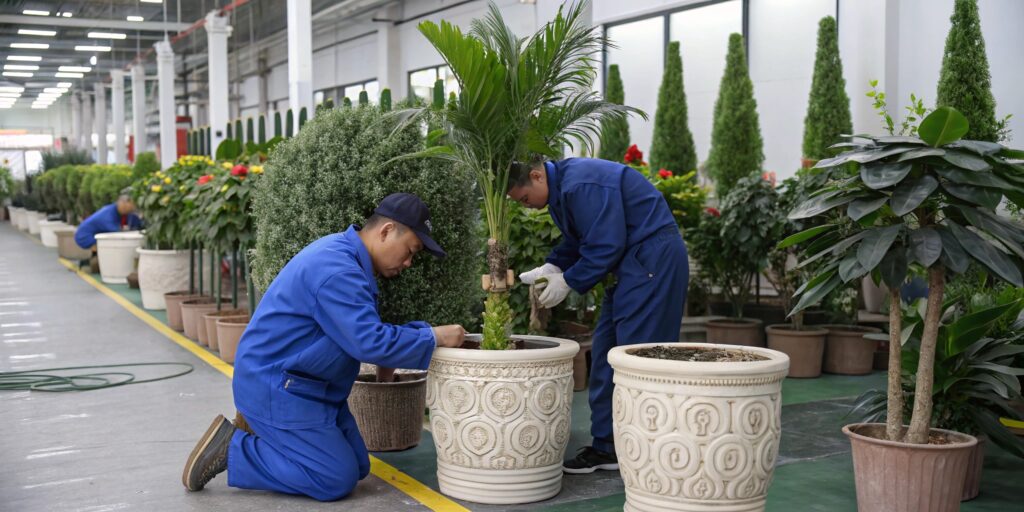
Why Leading Brands Choose FeelReal
FeelReal represents everything we believe artificial plants should be—compelling, meticulously crafted, and built to maintain their realistic appearance through years of demanding use. We’re not just another supplier moving inventory; we’re a manufacturer who understands what separates convincing faux greenery from obvious imitations.
Every piece undergoes rigorous quality control that exceeds industry standards. Our portfolio encompasses a diverse range of options, from delicate potted bonsai to massive statement trees, graceful hanging vines, elegant palms, and comprehensive custom outdoor landscaping solutions.
We collaborate directly with architects, interior designers, wholesalers, and commercial design firms worldwide who demand excellence. Ready to discover what artificial plants can accomplish when engineered properly? Choose FeelReal—where lifelike design meets manufacturing excellence.

FAQs about Artificial Plants
How often should my fake plants be cleaned?
Monthly deep cleaning is effective for most indoor pieces in typical environments. Outdoor plants and installations in dusty commercial spaces need bi-weekly attention.
Large trees and bushes attract dust more readily—don’t let maintenance slide.
Can fake plants be used outdoors?
Absolutely, but only pieces engineered explicitly for exterior conditions will maintain their appearance. Our UV-resistant, weather-hardy plants excel in patio spaces, balcony areas, backyard gardens, and commercial landscaping applications.
Standard indoor pieces will fade and deteriorate rapidly when exposed to outdoor conditions. For house exterior projects or outdoors, invest in weather-resistant options that maintain their lifelike appearance outside your home.

